What is incorporation?
Let’s start with a brief overview of what a company is. Basically defined, a company is a corporate vehicle with which your business is conducted through. Companies are a separate legal personality: you are your own personality (even if you are the founder), and the company is its own personality. Thus, this corporate vehicle separates yourself from your business and its liabilities, such as debts and lawsuits. This is important because if your company “fails” and goes into debt, the creditors can only make legal claims against your company and cannot chase after you yourself (with very few exceptions). For this reason, a vast majority of companies—whether private or public—are “limited liability” companies.
A company needs to go through the process of incorporation in order for it to be formed and recognised by law. The incorporation process will vary from jurisdiction to jurisdiction, but it broadly involves filing various documents to the relevant register of companies, preparing documents regarding how the company is to be run, as well as ensuring that the startup complies with relevant laws and regulations.
Below is a simplified timeline of incorporation. Some of these documents will be explained later on in this blog post:
- Founding members (founders) sign the articles of association
- Delivery of the following documents to the companies registry:
- Incorporation form, which has been completed and signed by the founders (each jurisdiction has its own specific incorporation form)
- Copy of the articles of association
- Payment of incorporation fee to the companies registry
- Issuance of certificate of incorporation by the companies registry
DocLegal.ai is an AI legal document generator which simplifies the incorporation process. Read on to find out more about how DocLegal.ai can generate startup incorporation document templates to get your startup off the ground.
Essential startup incorporation documents
This section discusses two key essential documents for new business legal setup: the articles of association and the shareholders’ agreement.
1. Articles of association
The articles of association prescribe the company’s regulations, akin to a mini ”constitution” laying out how the company is to be run. It is also a contract between the company and its shareholders (also known as “members”), thus the shareholders may sue the company to enforce the articles if they believe it was breached.
Some jurisdictions may also require certain details to be stipulated in the Articles. In Hong Kong these are known as “mandatory articles” and include:
- The name of the company
- Whether shareholders’ liability is limited or not
- How shareholders’ liability is limited (by shares or by guarantee)
- Capital and initial shareholdings at incorporation
In addition, some jurisdictions may also have a “default” set of articles in case the company does not come up with its own. In Hong Kong, these are called the Model Articles and can be found in the Companies (Model Articles) Notice (Cap. 622H) (“the Notice”). For illustrative purposes, below are a few of the Hong Kong Model Articles prescribed for private companies limited by shares, found in Schedule 2 of the Notice:
- Size of quorum for directors’ meetings: “The quorum for directors’ meetings may be fixed from time to time by a decision of the directors and unless otherwise fixed it is 2.” (Model Article 11(2))
- How directors are to be appointed: “A person who is willing to act as a director, and is permitted by law to do so, may be appointed to be a director—(a) by ordinary resolution; or (b) by a decision of the directors.” (Model Article 22(1))
- How dividends are made to shareholders: “The directors may from time to time pay the members interim dividends that appear to the directors to be justified by the profits of the company.” (Model Article 73(2))
Keep in mind that the Model Articles are not mandatory to adopt, but it will apply if your company does not write its own articles. Your startup is free to write your own articles as desired so long as it complies with the law. In Hong Kong, the main governing legislation is the Companies Ordinance (Cap. 622). For example, a director can only be removed by ordinary resolution at a general meeting per Companies Ordinance section 462(1), so any articles of association stating otherwise will not be effective.
For companies in England and Wales, the model articles of association can be found at https://www.gov.uk/guidance/model-articles-of-association-for-limited-companies.
In Australia, the Corporations Act 2001 has a set of “replaceable rules” which apply where a company does not adopt its own company constitution (i.e. a single document replacing the memorandum of association and articles of association). The replaceable rules can be found at https://www5.austlii.edu.au/au/legis/cth/num_act/ca2001172/s141.html.
In India, Schedule I of the Companies Act 2013 includes model articles in Tables F, G, H, I and J. It can be found at https://www.indiacode.nic.in/bitstream/123456789/2114/5/A2013-18.pdf.
Case study: articles of association
Rita and Taylor are shareholders of a startup company with shareholdings of 55% and 45% respectively. Rita wants the company to enter into a transaction which would cost the company $100,000 but Taylor disagrees. In the company’s articles of association which Ai-powered legal document generator DocLegal.ai helped draft, Rita and Taylor added a clause providing that transactions less than $110,000 only require an ordinary resolution (>50% of the shareholding) to pass. Taylor is in despair because he thinks that Rita can pass the resolution on her own (because she already has 55% of the shareholding). However, upon closer examination of the articles, he notices that article 37(1) states that two members must be present in order to constitute a quorum for a general meeting, and 37(2) states that “No business [...] is to be transacted at a general meeting if the persons attending it do not constitute a quorum”. This makes Taylor happy because he can simply decide not to show up to the general meeting where the $100,000 transaction is to be voted on, so that Rita on her own cannot meet the quorum requirement and no resolution can be passed at all.
2. Shareholders’ agreement
A shareholders’ agreement is an agreement between some or all shareholders to regulate their rights and obligations in the company.
Does your company need a shareholder agreement?
In most jurisdictions, a shareholder agreement is not legally required for every company—but it is often highly recommended, especially in companies with multiple shareholders. A shareholder agreement allows you to set out additional, customized arrangements regarding:
- Management and decision-making processes
- Transfer of shares and exit strategies
- Dividend policies
- Dispute resolution mechanisms
- Protection of minority shareholders
Without a shareholder agreement, disputes among shareholders may be more difficult to resolve, and you will be limited to the default rules under the Companies Ordinance and your company’s articles of association. A well-drafted shareholder agreement can help prevent misunderstandings and provide clarity on important issues.
Difference between shareholders' agreement and articles of association
A shareholders’ agreement provides for the manner of operating the company either not provided for under relevant company laws or in the articles of association. Usually, the shareholders’ agreement is more detailed than the articles.
Why provide for something in the shareholders’ agreement but not the articles of association?
- The articles of association must be registered with the relevant registry of companies, so they are open to inspection by the public.
- On the other hand, shareholders’ agreements are private agreements that need not be registered. This makes non-registered shareholders’ agreements ideal for privacy, because its terms can be kept confidential from the public.
Another difference between a shareholders’ agreement and the articles of association is that while both are agreements on how to run the company, the company is automatically a party to the articles of association—so it is always bound by the articles (meaning that it can always be sued for breaching the articles). Meanwhile, the company may be taken out of the shareholders’ agreement, making the company not bound by it. In that case, the shareholders’ agreement only creates personal obligations enforceable between the shareholders. Furthermore, shareholders’ agreements are not automatically binding. Thus, shareholders are only bound by the shareholders’ agreement if they consent to it, which is different from how the articles of association are automatically binding.
What to include in a shareholders' agreement?
Below are some key provisions in shareholders’ agreements:
- Scope of business
- Share capital (shareholders and their respective shareholdings)
- Board composition, quorum and decision-making process
- Who gets to appoint the directors
- Special quorum requirements to ensure representation
- Reporting of information to the shareholders
- Future financing obligations
- Dividend policy, i.e. a minimum percentage of profits to be declared as dividends
- Pre-emption rights, which grant a first right of refusal to existing shareholders for buying out the shares of another shareholder who wishes to sell to an outsider
Shareholders’ agreement: case study
Alice and Hayley are 50-50 shareholders in a pharmaceutical company that was founded to manufacture medical drugs. Hayley actively manages the day-to-day runnings of the company, while Alice is more of a passive investor and does not take much of a role in running the company. One day, Hayley comes across an “exciting” piece of news about cryptocurrency trends and decides she wants to turn the company into a crypto mining company. Hayley makes this change without passing a vote involving all shareholders. When Alice finds out, she is furious because she believes crypto is an incredibly unstable industry to enter. Fortunately, article 6.2 of the shareholders’ agreement generated by DocLegal.ai (signed by both Alice and Hayley) states that a “change in the nature of Business” is a “Reserved Matter” requiring all parties to the shareholders’ agreement to vote in favour before it can take place. Hayley has thus most likely breached the shareholders’ agreement because the nature of a crypto mining business is very different from that of a pharmaceutical company, thus Alice could take legal action against Hayley for this change—such as seeking a court injunction for Hayley to restore the company to its original business.
Do you need a Memorandum of Association?
A Memorandum of Association was historically a key constitutional document required for incorporating a company in Hong Kong. However, under the current Companies Ordinance (Cap. 622), the memorandum of association is no longer required for company incorporation. Instead, the articles of association serve as the sole constitutional document for companies formed under the current law.
For companies incorporated before the commencement of Cap. 622, the conditions in their memoranda are now deemed part of their articles of association. The memorandum typically set out the company's name, its objects (purpose), and the liability of its members, among other foundational matters. Now, these matters are addressed within the articles of association.
How to draft startup incorporation documents with DocLegal.ai
DocLegal.ai enables users to generate legal documents from lawyer-made templates, summarize complex contracts, highlight absent clauses, suggest improvements, and automatically update documents all through an intuitive AI chatbot, making legal workflows more reliable and efficient.
1. Start a new session on DocLegal.ai in “New Document”

2. Search for and select the document which best suits your needs. For demonstration, let’s generate a document providing for the articles of association of a new company.
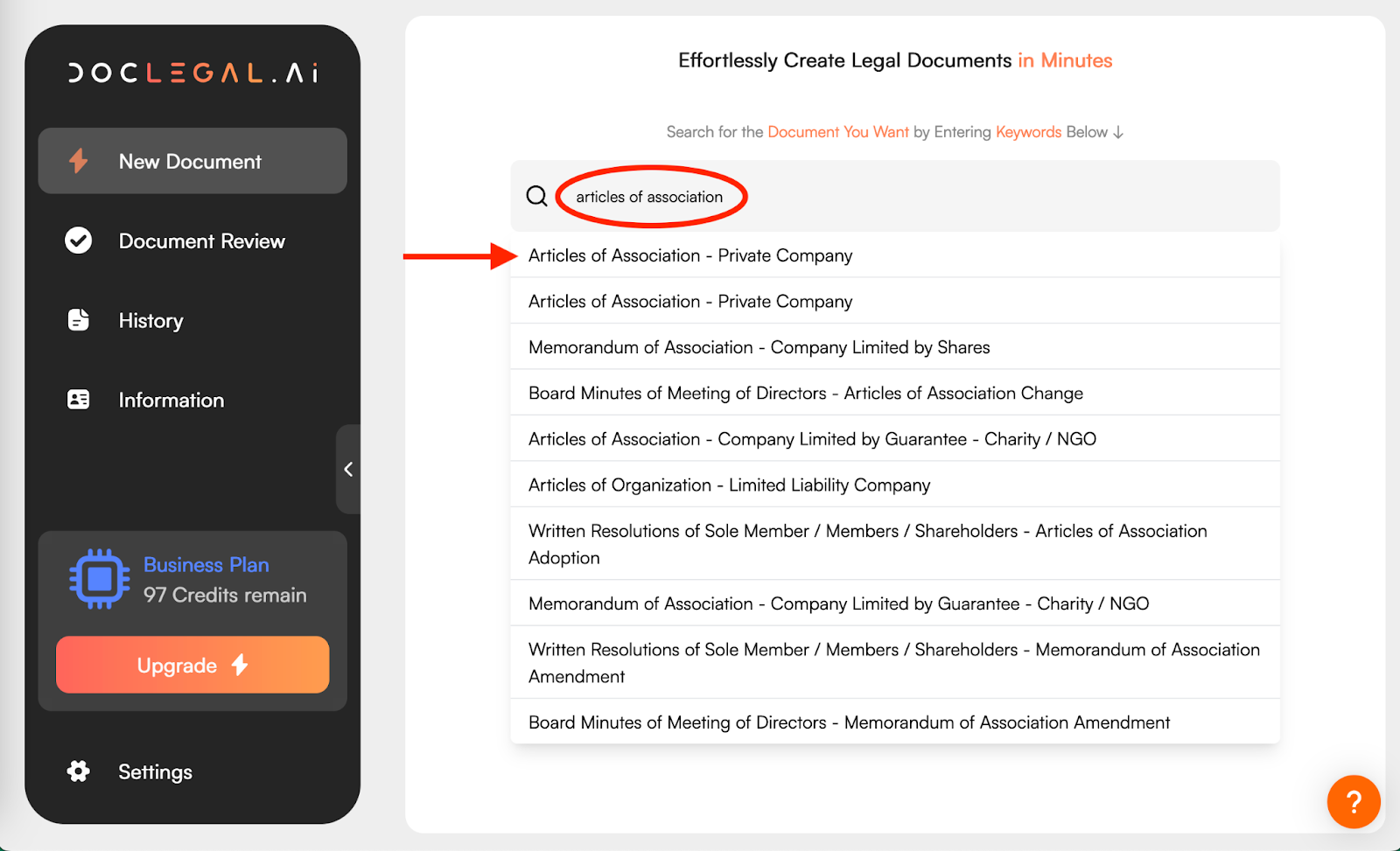
3. Describe the basic requirements of the document. You can edit the full document later on after seeing the draft agreement if you are unsure what to write at this stage.
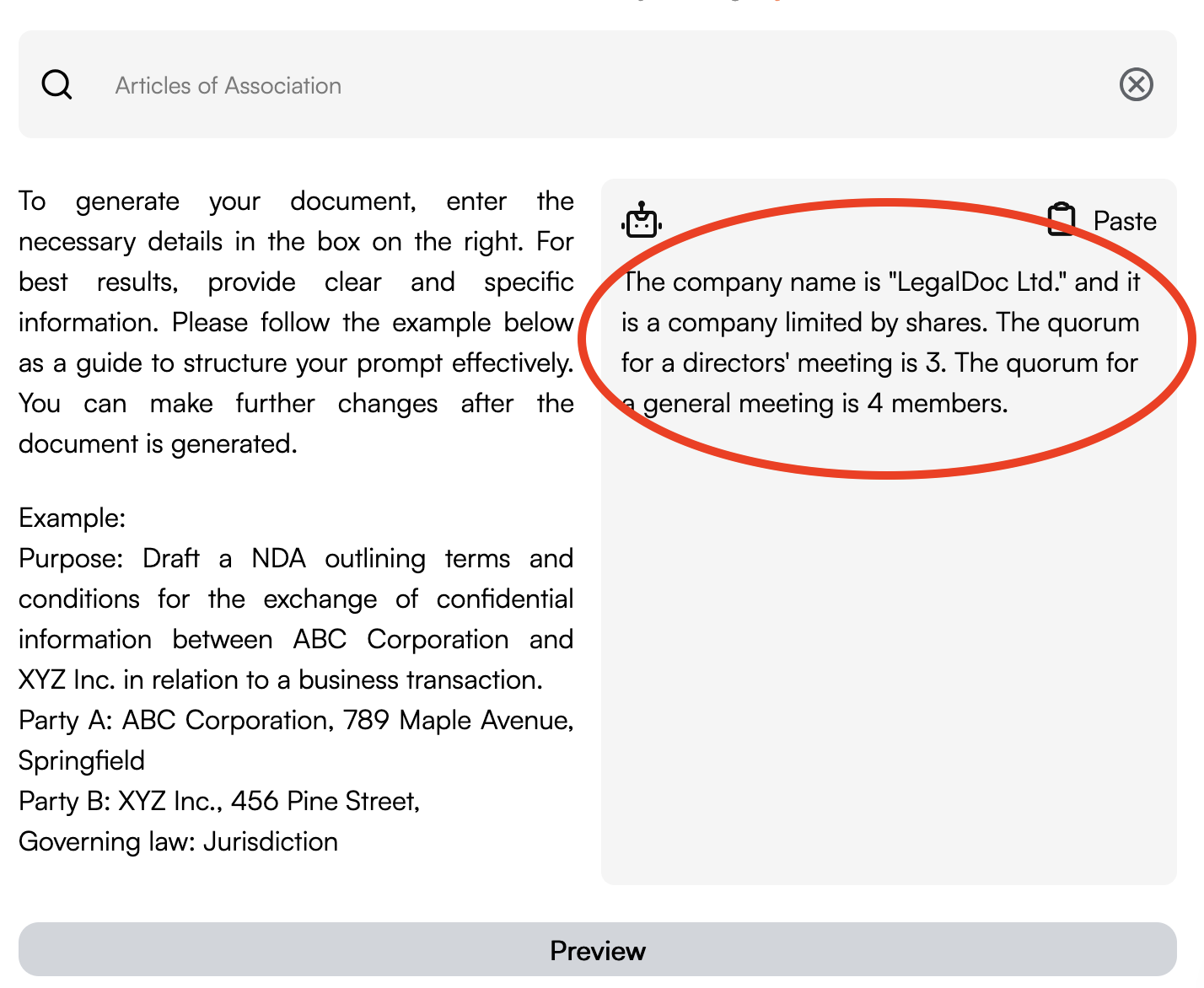
4. Click “Generate document” to generate the document draft, make further edits, and add more clauses.
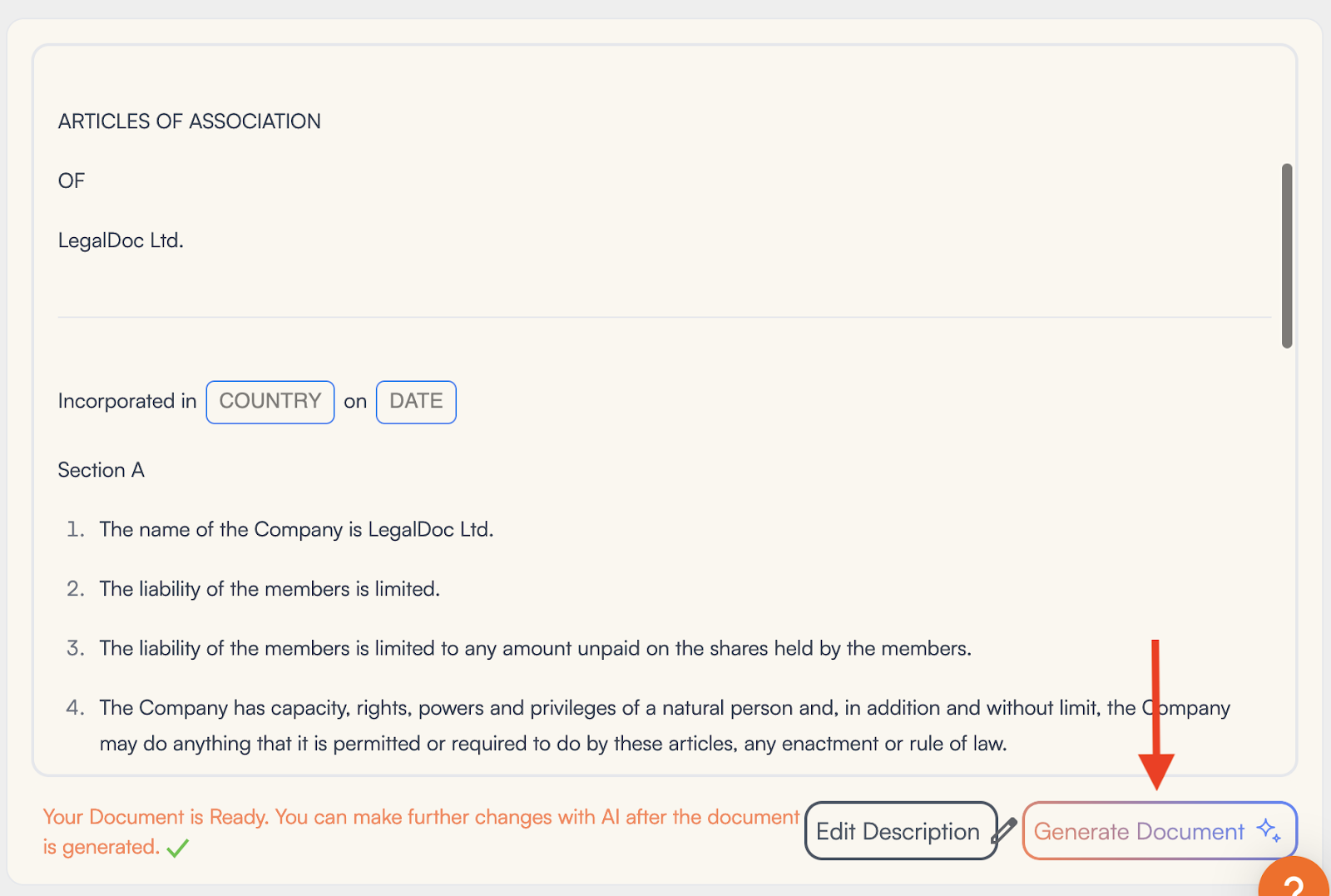
5. Use the “Document Review” chatbot to make further customisations to the document. When you are satisfied with the results, select “Proceed to Download” at the bottom right corner.
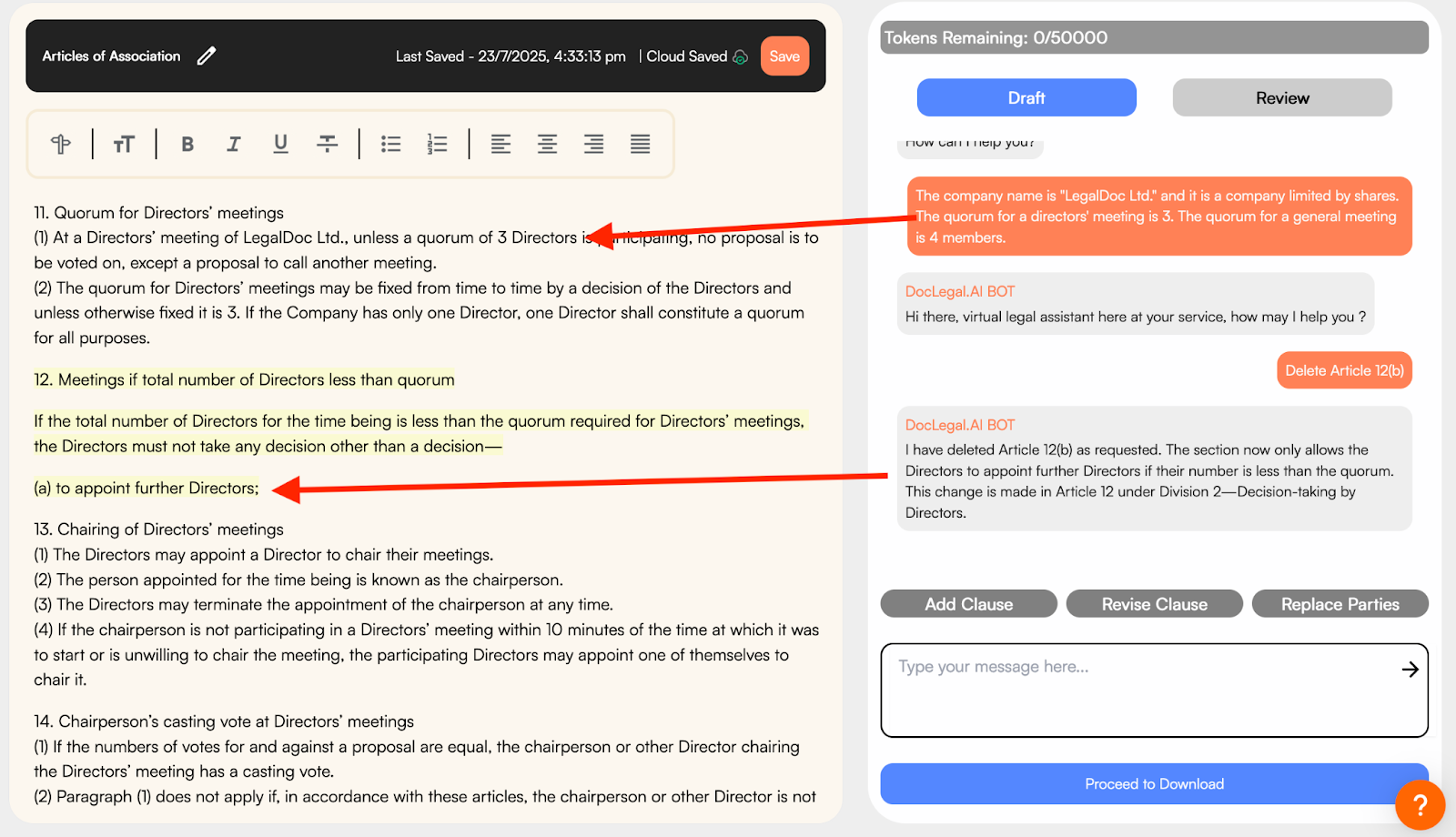
6. Select your preferred document format and download the finalised document! Tip: Downloading the document in Word or TXT file will allow further manual edits later on. Alternatively, download it as a PDF if you are satisfied with the document and do not wish to make any further manual changes.
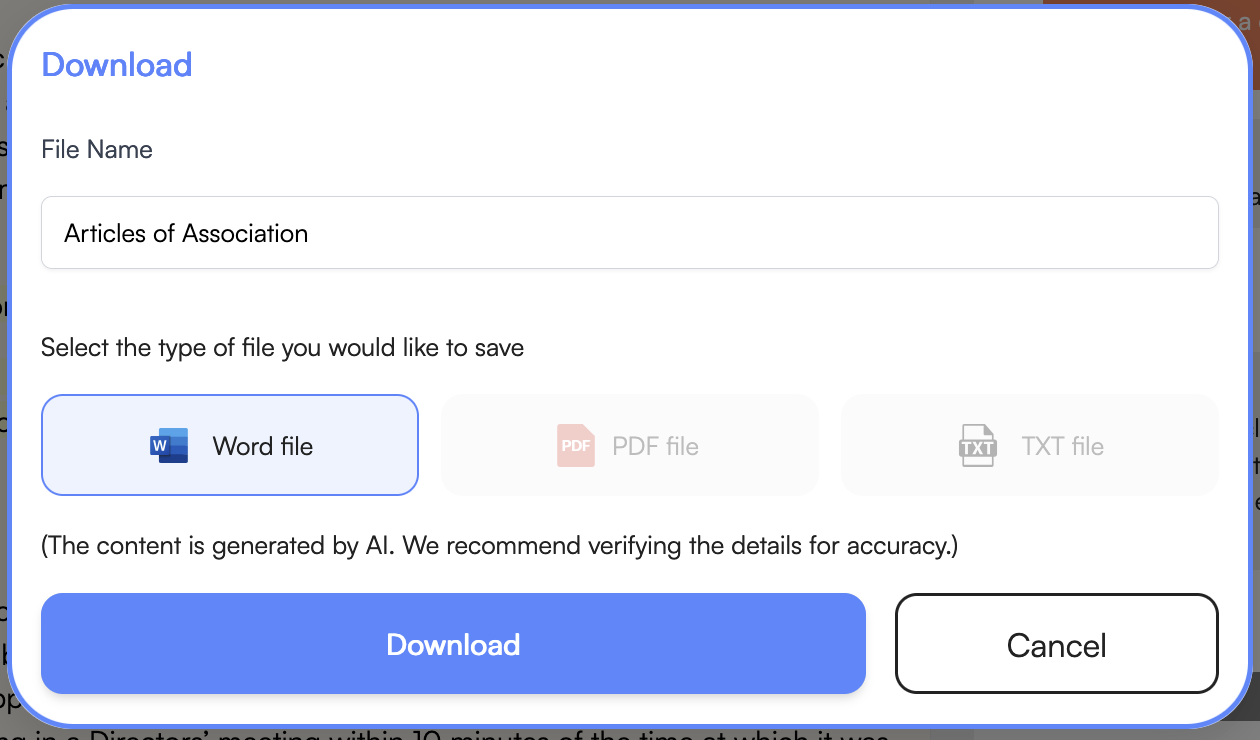
Types of startup incorporation documents on Doclegal.ai
Here are some examples of documents relevant to the incorporation process available on DocLegal.ai:
- Company Incorporation Checklist – Step-by-step guidance to ensure you complete all necessary steps.
- Articles of Association - The foundational rules governing your company’s operations and management.
- Operating agreement - Agreement detailing the management and operational structure (especially for LLCs or similar entities).
- Shareholders agreement - Contract outlining the rights and obligations of shareholders and how the company will be governed.
Frequently asked questions
“Can I upload my company's Articles of Association and use DocLegal.ai to customize it?”
Yes, you can! DocLegal.ai allows you to upload your company’s Articles of Association or other legal documents. Once uploaded, our AI-powered platform can help you analyze, summarize, and suggest customizations based on your requirements. This makes it easier to review and update your documents efficiently.
1. Can I change the articles of association after my company has been incorporated?
Yes. However, you must do this in compliance with the relevant laws in your jurisdiction concerning altering the company’s articles.
For example, under section 87(1) and sections 88(1)-(2) of the Companies Ordinance in Hong Kong, the alteration of articles requires a special resolution. This means that ≥75% of the company’s shareholding must vote to alter the articles.
There is also a template for ‘Written Resolutions of Sole Member / Members / Shareholders’ used to formally approve changes to the company’s Articles of Association and is available on DocLegal.ai.
2. Can I change the shareholders’ agreement after my company has been incorporated?
Like the answer above, you may change the agreement subject to compliance with the relevant laws in your jurisdiction concerning altering the company’s shareholders’ agreement.
3. DocLegal.ai has incorporation documents for companies limited by shares and companies limited by guarantee. What is the difference between these types of companies?”
A shareholder’s liability to the company (i.e. in case the company “fails” and creditors are chasing up on its debt) can be limited by shares or by guarantee.
Company limited by shares: a shareholder's liability for the company's debts is limited to any amounts unpaid on their shares
- For example, you bought five shares in the company which cost $100 in total. You already paid the full $100 to purchase those five shares, so your liability ends here. If the company goes under, creditors cannot chase you for any more money as a shareholder.
- What if you agreed to buy five shares for the same price, but instead paid in installments and only paid $80 so far? If so, you are still liable to pay the $20 unpaid on the shares. After this, the extent of your liability towards the company’s debts ends here.
Company limited by guarantee: a shareholder’s liability is limited to the specific amount the member undertakes (agrees) to contribute in the event of a winding-up (i.e. goes insolvent and creditors demand the company’s dissolution so that its assets can be used to satisfy debts). Companies limited by guarantee are often NGOs and charities, and thus are rarer than companies limited by shares.
4. What should founders watch out for when drafting shareholders’ agreements?
When founders draft shareholders’ agreements, there are several critical considerations to ensure the agreement is robust, fair, and minimizes future disputes. Here are some key points to consider:
- Clear Definition of Rights and Obligations
- Decision-Making and Deadlocks
- Transfer of Shares
- Management and Board Structure
- Exit Strategies
- Dispute Resolution
- Implied Terms and Fiduciary Duties
- Unfair Prejudice and Minority Protection
- Consistency with Company’s Articles
- Governing Law and Jurisdiction
5. Can a shareholders' agreement override articles of association?
A shareholders' agreement cannot override the articles of association in matters of the company's internal governance or in relation to third parties. The articles of association prevail in such circumstances. However, a shareholders' agreement may regulate the relationship between its parties and provide for remedies if breached, meaning that shareholders still owe personal obligations to one another based on the shareholders’ agreement which can be enforced by the shareholders between or among themselves. Still, a shareholders’ agreement cannot bind the company to act contrary to its articles.
6. Is the operating agreement the same as the articles of association?
No, an operating agreement is not the same as the articles of association.
In Hong Kong, the articles of association are the company’s primary constitutional document and registered with the Companies Registry. They govern the company's internal management, rights and obligations of members, and the relationship between the company, its shareholders, and directors.
An operating agreement (as it is called in some jurisdictions) is a private arrangement between shareholders, similarly to shareholders’ agreements. These are private contracts between shareholders that set out rules on management, voting, transfer of shares, etc., but do not replace or override the articles of association.

.jpg)



.jpg)

.jpg)